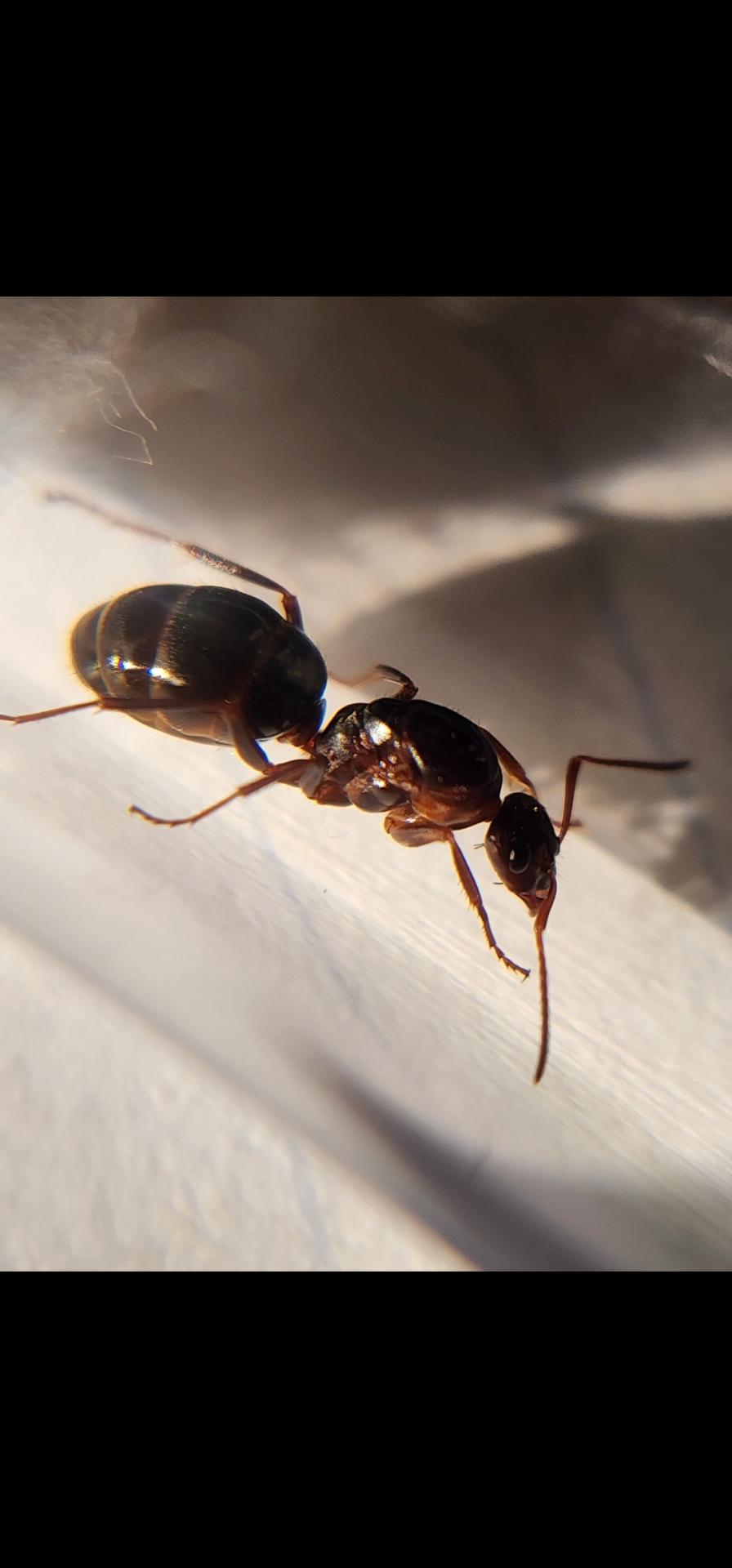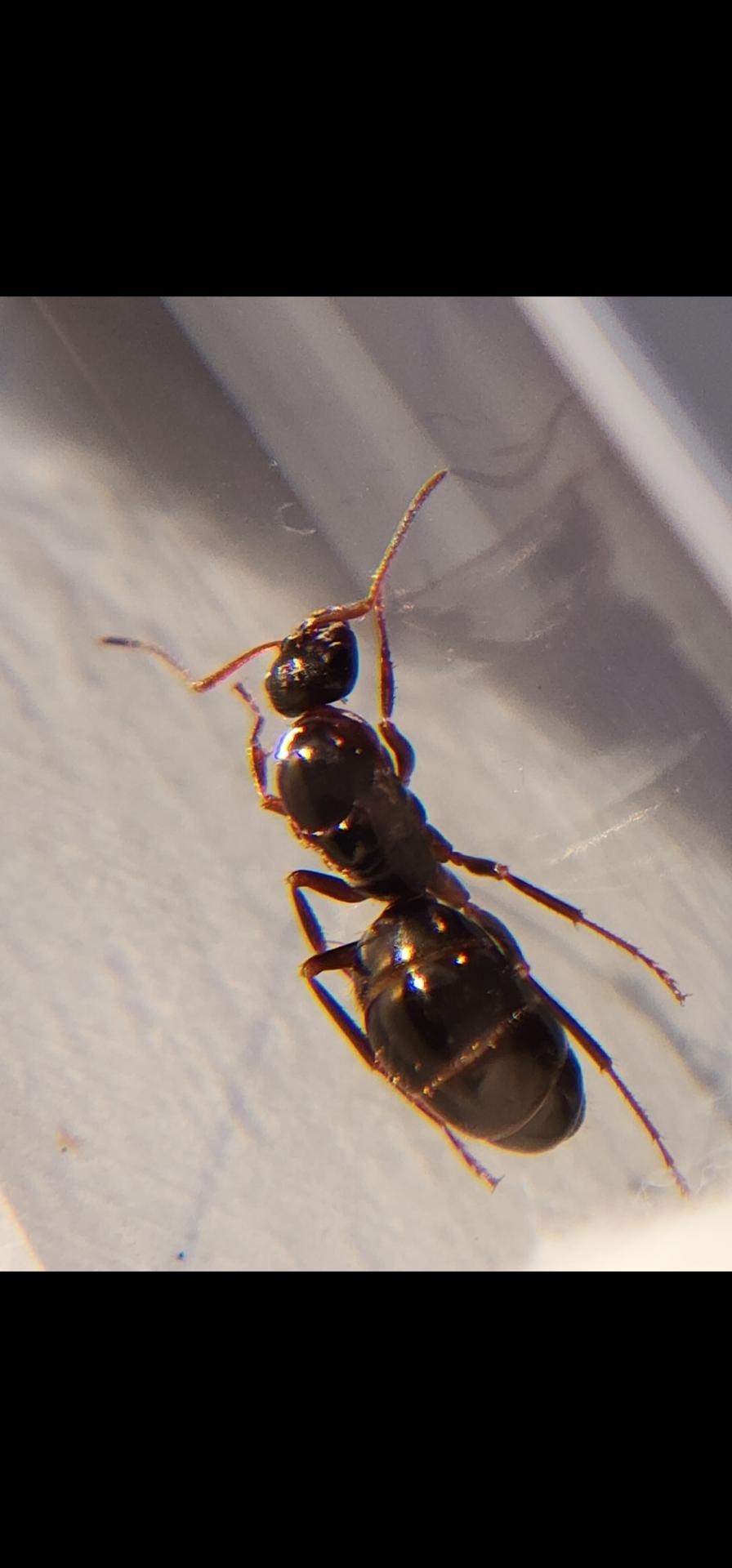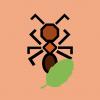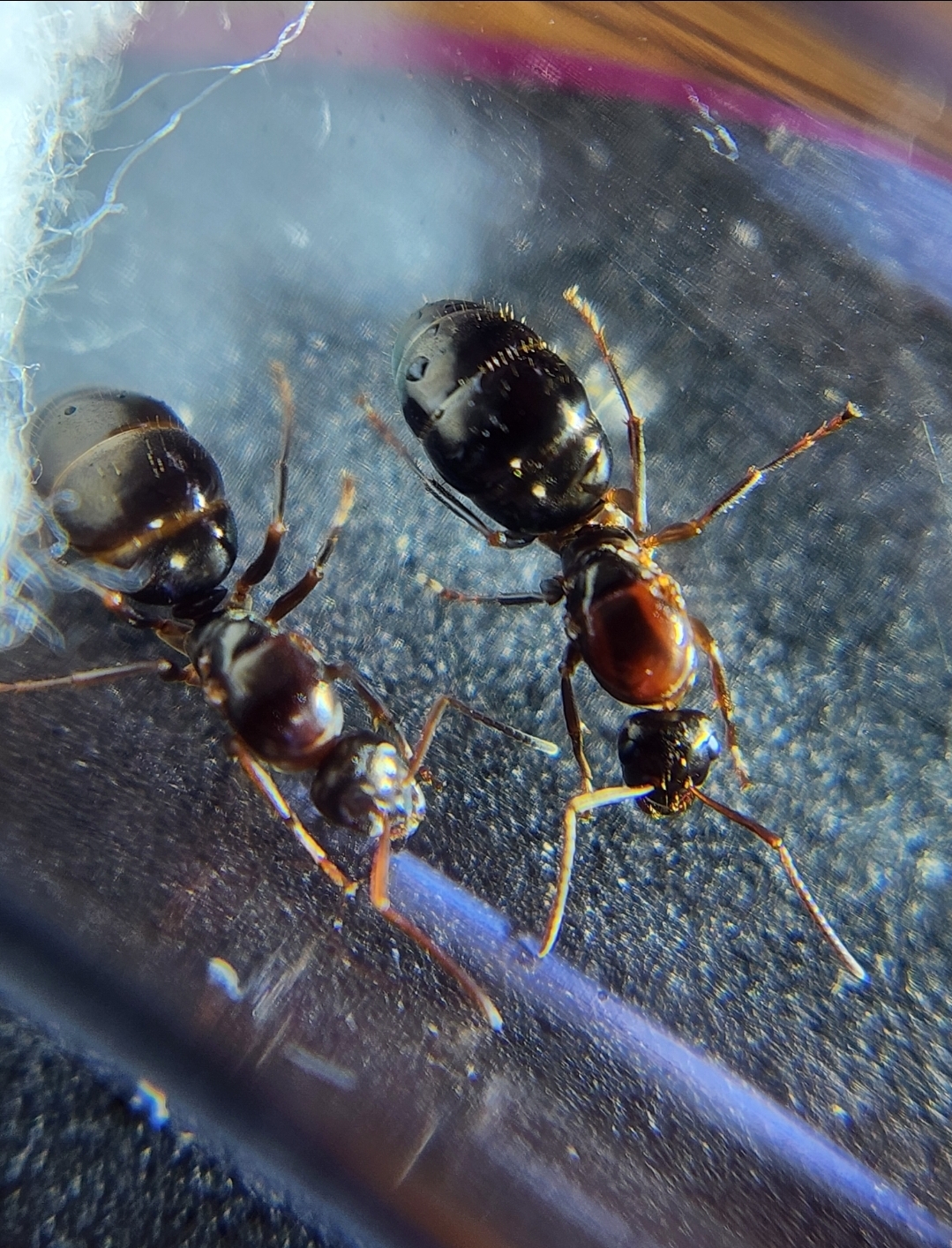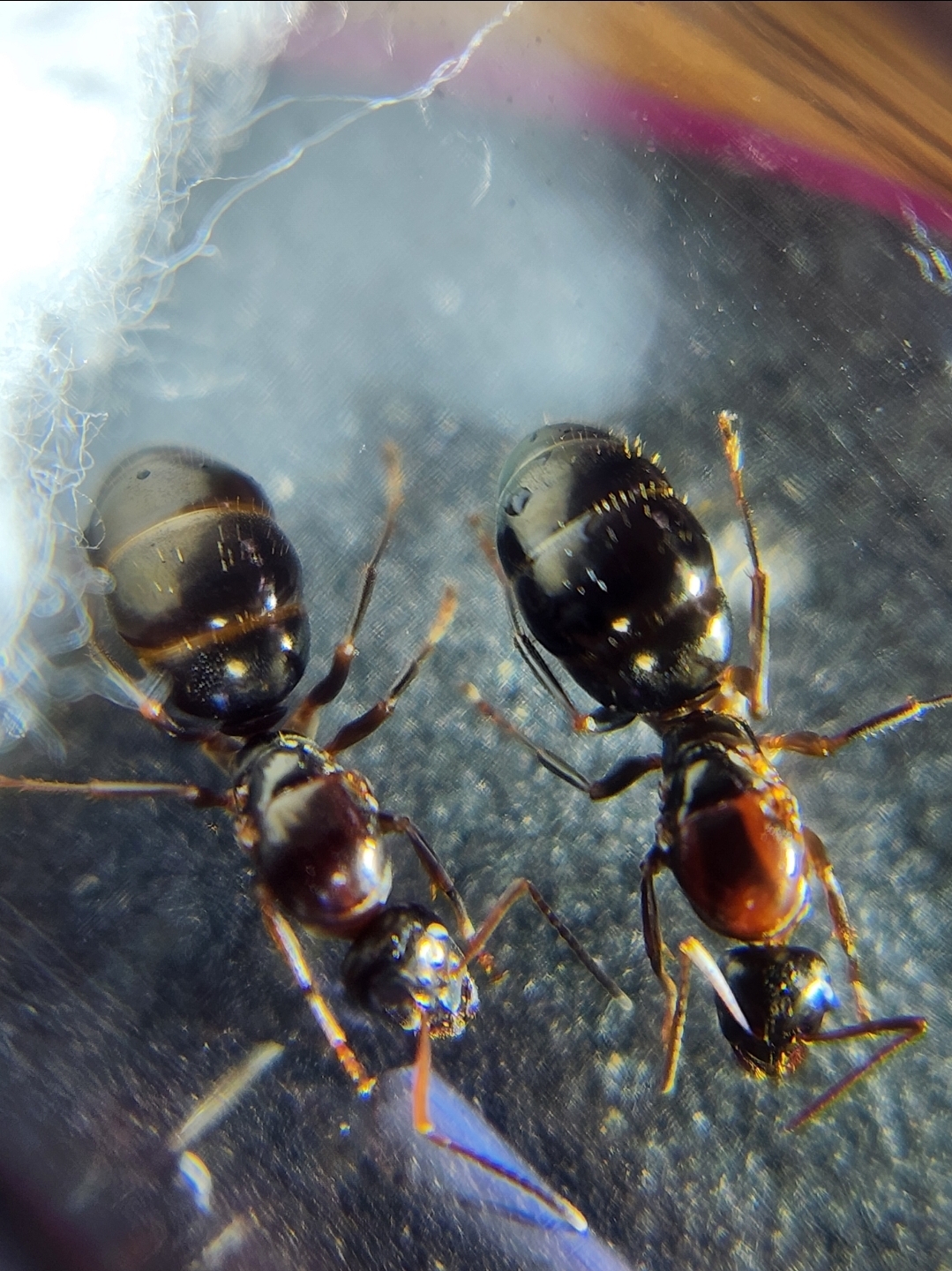- Formiculture.com
- Forums
- Gallery
- Members
- Member Map
- Chat

Formica queen ? Wisconsin 7/9/25
Started By
TheGamblingAnt
, Jul 9 2025 5:31 PM

13 replies to this topic
#1
 Offline
-
Posted July 9 2025 - 5:31 PM
Offline
-
Posted July 9 2025 - 5:31 PM
1. Location (on a map) of collection: Southeast Wisconsin
2. Date of collection: 7/9/25
3. Habitat of collection: on a path in a park surrounded by woods.
4. Length (from head to gaster): about 9- 10mm
5. Color, hue, pattern and texture: mostly black with a hint of a reddish color.
6. Distinguishing characteristics:
7. Distinguishing behavior: very skittish and very fast.
8. Nest description: n/a
9. Nuptial flight time and date:
This has got to be some sort of Formica queen. We have a ton of Formica Subsericea here in WI and this is not that for sure. Wondering what your thoughts are on this queen ? Closest I can see on Google looks to be a Formica rufa. If that's the case, that means she is a parasite queen? Otherwise maybe thinking by pictures maybe Formica cunicularia? Never even heard of that one before today but does look like they're in Wisconsin so maybe ? Appreciate the help as always!
2. Date of collection: 7/9/25
3. Habitat of collection: on a path in a park surrounded by woods.
4. Length (from head to gaster): about 9- 10mm
5. Color, hue, pattern and texture: mostly black with a hint of a reddish color.
6. Distinguishing characteristics:
7. Distinguishing behavior: very skittish and very fast.
8. Nest description: n/a
9. Nuptial flight time and date:
This has got to be some sort of Formica queen. We have a ton of Formica Subsericea here in WI and this is not that for sure. Wondering what your thoughts are on this queen ? Closest I can see on Google looks to be a Formica rufa. If that's the case, that means she is a parasite queen? Otherwise maybe thinking by pictures maybe Formica cunicularia? Never even heard of that one before today but does look like they're in Wisconsin so maybe ? Appreciate the help as always!
#2
 Offline
-
Posted July 9 2025 - 5:36 PM
Best Answer
Offline
-
Posted July 9 2025 - 5:36 PM
Best Answer
#3
 Offline
-
Posted July 9 2025 - 8:56 PM
Offline
-
Posted July 9 2025 - 8:56 PM
How certain are you that's correct? The images on Google of that species queen really doesn't look like the queens I caught today. That looks far too red/orange. The ones I caught today look almost all black until in the sunlight it brings out the red color
#4
 Offline
-
Posted July 9 2025 - 10:51 PM
Offline
-
Posted July 9 2025 - 10:51 PM
Formica rufa aren’t in the US and this is certainly a claustral queen rather than parasitic. It’s worth mentioning that morphology is more important than color when it comes to ID. Mett knows what he’s doing and is a top IDer here.
"Float like a butterfly sting like a bee, his eyes can't hit what the eyes can't see."
- Muhammad Ali
Check out my shop and Formica journal! Discord user is bmb1bee if you'd like to chat.
Also check out my YouTube channel: @bmb1bee
#5
 Offline
-
Posted July 10 2025 - 2:10 AM
Offline
-
Posted July 10 2025 - 2:10 AM
Southern pallidefulva are lighter in color, while northern populations are usually darker. I second Mett’s call here.
"The ants are a people not strong, yet they prepare their meat in the summer." Prov. 30:25
Keep ordinary ants in extraordinary ways.
Keep ordinary ants in extraordinary ways.
#6
 Offline
-
Posted July 10 2025 - 6:22 AM
Offline
-
Posted July 10 2025 - 6:22 AM
How certain are you that's correct? The images on Google of that species queen really doesn't look like the queens I caught today. That looks far too red/orange. The ones I caught today look almost all black until in the sunlight it brings out the red color
I third Mettcollsus. Northern Formica pallidefulva populations are dark just like yours. Southern populations are bright orange. The populations here in southeastern South Dakota and eastern Nebraska are dull orange with a lot of brown and red mixed in, a color and geographical in-between. Color for this species is a spectrum: the further north you are, (generally) the darker the ants, and vice versa.
"God made..... all the creatures that move along the ground according to their kinds (including ants). And God saw that it was good. Genesis 1:25 NIV version
Keeping:
Tetramorium immigrans Camponotus vicinus, modoc, novaeboracensis, herculeanus
Formica pallidefulva, argentea Solenopsis molesta
Formica cf. aserva Lasius brevicornis, neoniger
#7
 Offline
-
Posted July 10 2025 - 6:27 AM
Offline
-
Posted July 10 2025 - 6:27 AM
Once again, I’m dying of jealousy to see how easy it is for people to find Formica. I can’t even buy one here.
- RushmoreAnts likes this
"The ants are a people not strong, yet they prepare their meat in the summer." Prov. 30:25
Keep ordinary ants in extraordinary ways.
Keep ordinary ants in extraordinary ways.
#8
 Offline
-
Posted July 10 2025 - 6:38 AM
Offline
-
Posted July 10 2025 - 6:38 AM
Sounds good thank you very much guys! I didn't realize the color wasn't very important, I was basically looking at the colors first to make my guesses. I'm still learning all of these things so as always greatly appreciate your help! One last question wondering you guys opinion, it looks like this species is polygynous. I caught 2 of them yesterday, would you guys put them together in the same tube or 2 separates? I have had them in separate tubes overnight now, not sure if it's worth distribing them and combining into the same?
#9
 Offline
-
Posted July 10 2025 - 6:42 AM
Offline
-
Posted July 10 2025 - 6:42 AM
Once again, I’m dying of jealousy to see how easy it is for people to find Formica. I can’t even buy one here.
I'm not sure how easy it is here in WI yet but we do have tons of Formica. Mostly subsericea though, I might have been lucky to find these 2 yesterday! I did find 1 Subsericea queen yesterday as well. I've had tons of male Formica ants on my blacklights at night time, but haven't seen any queens on the lights. All 3 of these I found just running on paved paths going for a walk in the morning.
#10
 Offline
-
Posted July 10 2025 - 11:09 AM
Offline
-
Posted July 10 2025 - 11:09 AM
In this case the coloration actually is important. Yes, coloration is variable, so you should always be familiar with the extent of a taxon's variation before using it for ID, but it can be used in some cases. The two most common members of the pallidefulva group up north are pallidefulva and incerta, both of which vary in color, but the former is more variable than the latter -- incerta varies from a yellow-orange to a bicolored medium brownish, and pallidefulva varies from pale yellow to black. The 3rd species that occurs up north is dolosa, which also does not get this dark. The only other member of the pallidefulva group that is dark brown to black is archboldi, which is limited to Florida and bordering states. Thus the combination of a northern locality and a dark, near-black coloration makes this pallidefulva. In addition, the thorax patterning, or rather the lack thereof, cements this ID -- incerta and dolosa queens both have three mesoscutal maculations (a set of dark spots on the top of the thorax), while they are absent in pallidefulva queens.
- ANTdrew, RushmoreAnts and Ants_Dakota like this
#11
 Offline
-
Posted July 15 2025 - 11:12 AM
Offline
-
Posted July 15 2025 - 11:12 AM
Caught 2 more Formica pallidefulva this morning and I'm trying them both in the same tube. They aren't fighting with each other but are very skittish like Formica is typically. The other two I caught earlier in the week I have in separate tubes and haven't checked on them yet. Think these two will be ok in the same test tube ? Per what I read on these it says they should be fine like most Formica.
Edited by TheGamblingAnt, July 15 2025 - 12:16 PM.
#12
 Offline
-
Posted July 15 2025 - 12:02 PM
Offline
-
Posted July 15 2025 - 12:02 PM
Caught 2 more Formica pallidefulva this morning and I'm trying them both in the same tube. They aren't fighting with each other but are very skittish like Formica is typically. The other two I caught earlier in the week I have in separate tubes and haven't checked on them yet. Think these two will be ok in the same test tube ? Per what I read on these it says they should be fine like most Formica.
Yeah it should be fine. I've seen polygynous colonies in the wild (I saw like 10 queens of the same colony after opening 3 rocks. Definitely a lot more than that though).
Keeping:
5x - S. molesta (founding) 2x - C. pennsylvanicus (colonies)
4x - C. chromaiodes (colonies)
4x - T. immigrans (founding queens and colonies)
1x - F. subsericea (founding)
Check out my C. nearcticus journal here: https://www.formicul...cticus-journal/
Check out my C. chromaiodes journal here: https://www.formicul...aiodes-journal/
#13
 Offline
-
Posted July 15 2025 - 12:15 PM
Offline
-
Posted July 15 2025 - 12:15 PM
After tubing them up and waiting for them to calm down so I could get a photo. They actually do look a bit different. Similar, but maybe different. Can you guys tell if these are ok together? I've separated them for now because I think they look slightly different. Their gasters look different and same with their thorax. One has less hair on the gaster also. I'm wondering maybe the one on the left is a Formica dolosa and the one on the right is a Formica pallidefulva? Would love your input! Thank you
Edited by TheGamblingAnt, July 15 2025 - 12:36 PM.
#14
 Offline
-
Posted July 15 2025 - 4:13 PM
Offline
-
Posted July 15 2025 - 4:13 PM
As previously mentioned, Formica pallidefulva varies widely in color variations. If they were a different species, they would either fight or get as far away from each other as possible. From the picture it seems like they're getting along fine. Many populations of most claustral Formica species are polygynous. Worst case scenario is they're pleometrophic, which the workers would likely take care of, leading to only one queen fatality, leaving the strongest and healthiest one with a larger first generation. I'd bet on them being polygynous, though.
- Artisan_Ants likes this
"God made..... all the creatures that move along the ground according to their kinds (including ants). And God saw that it was good. Genesis 1:25 NIV version
Keeping:
Tetramorium immigrans Camponotus vicinus, modoc, novaeboracensis, herculeanus
Formica pallidefulva, argentea Solenopsis molesta
Formica cf. aserva Lasius brevicornis, neoniger
1 user(s) are reading this topic
0 members, 1 guests, 0 anonymous users



